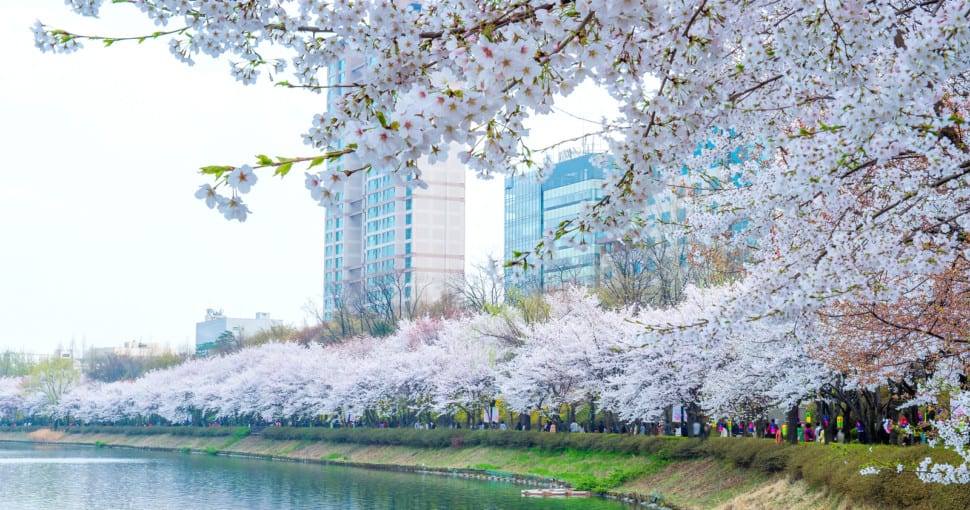Few trees can rival the exquisite displays of cherry blossoms’ spectacular flowers, in all of their splendiferousness, during the spring bloom. But is the cherry blossom unique in this stunning display, or are there trees similar to cherry blossoms?
Contents
Cherry blossoms belong to the genus Prunus, which contains around 400 species of shrubs and trees belonging to the Rose family (Rosaceae), which includes:
This family is diverse, and many species are economically significant (food and ornamental plants), including cherry trees. Many large-flowered species produce a sour/undesirable fruit (or no fruit) and are grown for ornamental reasons.
Cherry blossoms are adapted to temperate and subtropical conditions of the northern hemisphere, where temperatures do not fluctuate into the extremes.
In terms of symbolism, cherry blossoms are associated with renewal and friendship. Most cherry trees live 16 to 20 years, while others attain close to 250. These trees also vary in height, the smallest of which is 6 feet, the tallest around 80 feet, and the average height of 25 to 40 feet.
In the US, two of the most widespread cherry blossom varieties are the “Yoshino” and the “Kwanzan.” The first trees sent across in 1910 were deemed unwanted due to insect infestations. But, in 1912, they gladly received the subsequent gift. Cherry trees have been popular in Japan since the Heian Period (794–1185).
Two Main Cherry Tree Varieties
There are hundreds of different varieties within the cherry trees themselves, each similar to the Japanese flowering cherry (Prunus serrulata) but often with slight variations. Some of these cherry varieties include:
Sour Cherry
Sour cherries (Prunus cerasus) are originally from Europe and southwest Asia. They are deciduous, with white flowers appearing in the spring, and require less cold exposure than sweet cherry varieties.
When left uncultivated, these trees can reach up to 50 feet but usually only reach between 20 and 30. They have red-brown bark, which comes off in long horizontal segments. Like most cherry trees, their leaves are with an oval shape and serrated margins.
Although sour cherries are edible, most people prefer not to eat them raw due to their sour taste and rather use them for cooking. These trees are also not as aesthetically appealing as the P. serrulata and are grown rather as fruit trees.
Sweet Cherry
The sweet cherry (Prunus avium) is the most commonly available commercial cherry fruit. These fruits are eaten raw and used in cooking various meals. They are also deciduous trees and produce white five-petalled flowers in the spring.
These trees are suitable as shade trees and reach heights of 35 feet. The leaves of these trees look similar to most cherry leaves, with an oval shape, moving to a pointed tip and serrated edges. As with many cherry tree species, these trees have poisonous stems, leaves, and nuts.
Their original distribution included Europe, northwest Africa, Turkey, and western Asia. They prefer warmer temperatures. However, these trees need a certain amount (depending on the variety) of cold days to produce large amounts of fruit.
See all Sweet Cherry Varieties here
Trees Similar To Cherry Blossom
1. Almond Trees
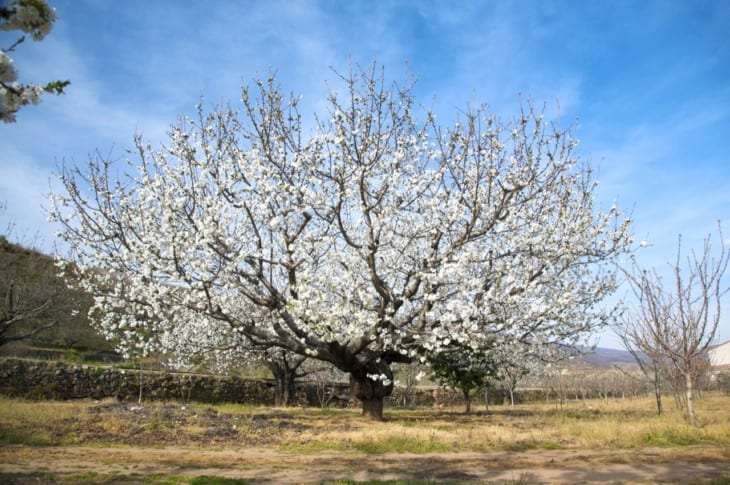
Almonds (Prunus dulcis) are within the same genus as cherry trees and share similar features. Like many cherry trees and particularly ornamental cherry blossoms, these trees are deciduous; they originate from Asia and grow to 15 to 20 feet, comparable to Prunus serrulata, the Japanese Flowering Cherry Tree.
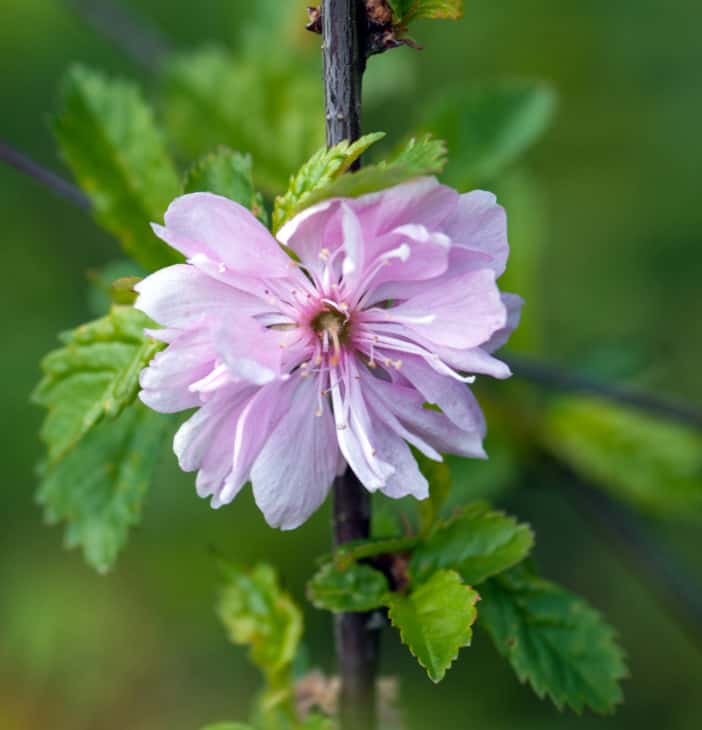
Other similarities include their flowers’ appearance. Both species have five-petalled pink to white colored flowers which appear during spring. A cherry tree’s leaves are oval with pointed tips and toothed edges. Deciduous varieties have dark green leaves in spring and summer, which turn yellow or orange during the fall.
Almond leaves share the toothed edges but are less oval. The bark of both trees is usually a gray or brown color. Almonds, like cherries, are important food crops, but both make great bonsai trees.
2. Apple Trees
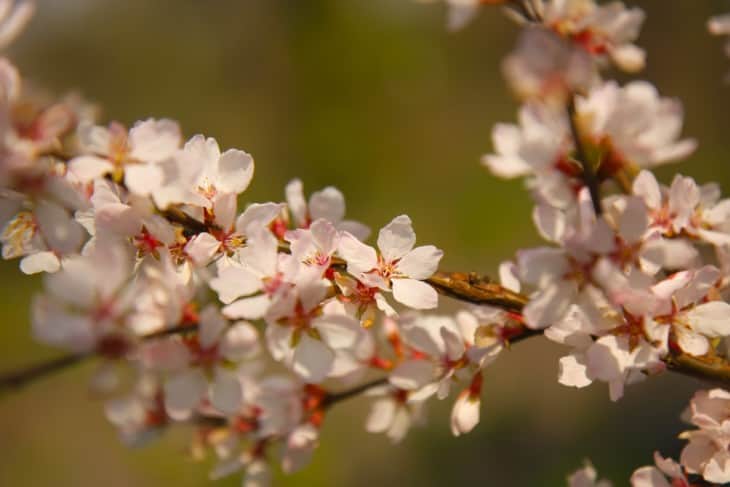
Malus domestica, or the apple tree, is a domesticated member of the rose family. Most members of this family share certain characteristics. Apple trees, like cherry trees, are found in temperate regions; however, apple trees occur in both hemispheres. Both types of trees are mostly deciduous.
Apple trees have five-petalled white to pale pink flowers, which bear a resemblance to cherry blossoms. Apple blossoms do, however, have red to pink undersides. Apple trees range in heights from dwarf trees of 6 feet to taller trees of 30 feet.
The bark of an apple tree shares the cherry’s gray coloration but is usually in various stages of peeling, giving it a “scaly” appearance. Apple tree leaves are oval with finely toothed margins, from bright to dark green. The fruit of both apple and cherry trees is also economically important.
3. Apricot Trees
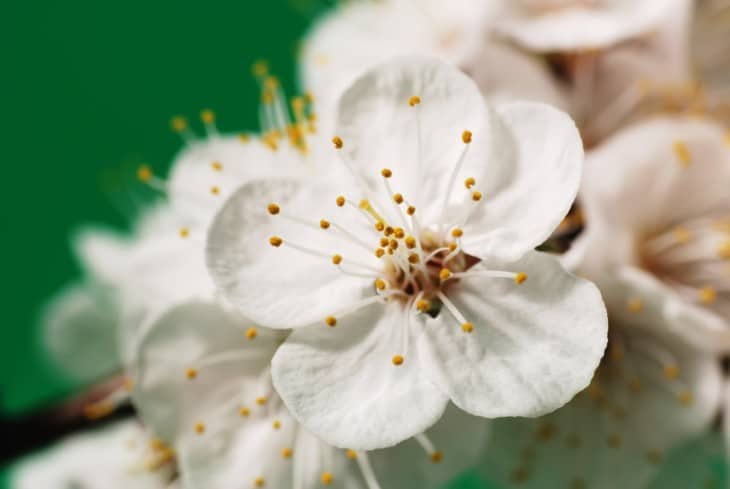
Aside from regular apricot trees (Prunus armeniaca), which produce economically significant fruits, the Japanese flowering apricot (Chinese plum) (Prunus mume) is a prized ornamental deciduous tree. Although they are tolerant of cold weather, they do better in temperate zones.
They reach between 10 and 20 feet tall and boast pink, rose, or white five-petalled flowers. Their leaves share the same dark green color, generally oval shape, and serrated edges of cherry trees.
Although these ornamental trees are not grown for their fruit in America, they share the typical “stone fruits” or drupes in the Prunus genus. The Japanese and Chinese do, however, use this species’ fruits in traditional meals and drinks.
4. Peach Trees
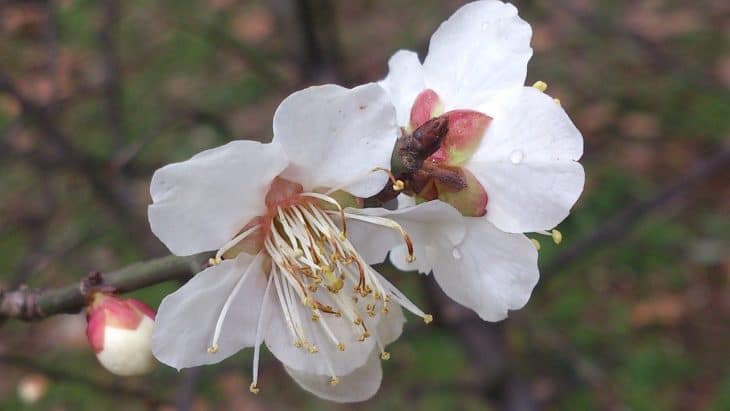
Peach trees (Prunus persica) are closely related to the cherry tree. Peach trees, however, are found in the warmer temperate areas of both hemispheres. Both species are, however, originally from East Asia.
Although peach trees have similar five-petalled pink flowers, they differ from cherry’s because they have magenta-colored centers and lack the diagnostic cleft on top of each petal. Peach trees also have tear-drop-shaped petals.
Peach trees usually reach a maximum of around 21 feet, with most kept around 10 to 13 feet. Like cherries, peaches produce a desirable fruit of economic significance, and like cherry trees, they are deciduous trees, losing their leaves in the fall.
5. Plum Trees
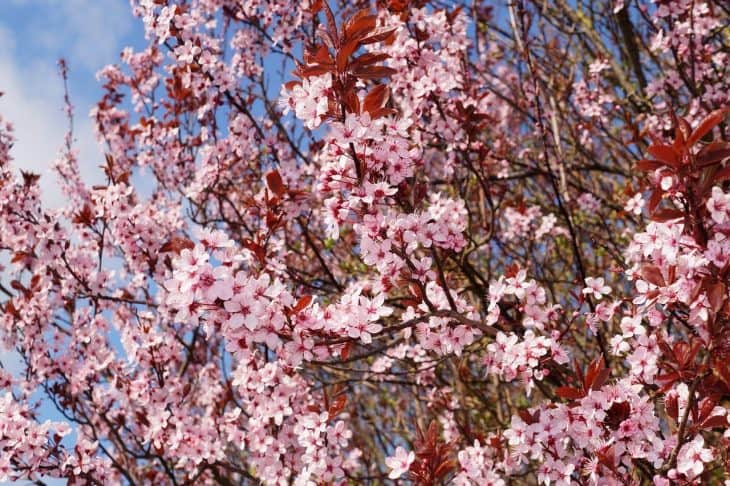
Fruit-bearing plum trees also belong to the Prunus genus. The Japanese plum (Prunus salicina) is a more commonly fruit-producing plum species. These trees originate from Asia (like the cherry) and are deciduous. Another commonly grown commercial tree is the European plum (P. domestica).
An example of an ornamental plum is the purple-leafed plum (Prunus cerasifera “nigra”), which, as the name suggests, has purple leaves. Most plums grow to between 20 and 30 feet. The Japanese plum has white five-petalled flowers and green leaves with serrated edges.
Plum blossoms are generally more round in shape, and some varieties are purple. The black knot is a fungus that attacks cherry and plum trees, resulting in reduced fruit production. Plum season typically runs from May to October in the US.
6. Blue Jacaranda Trees
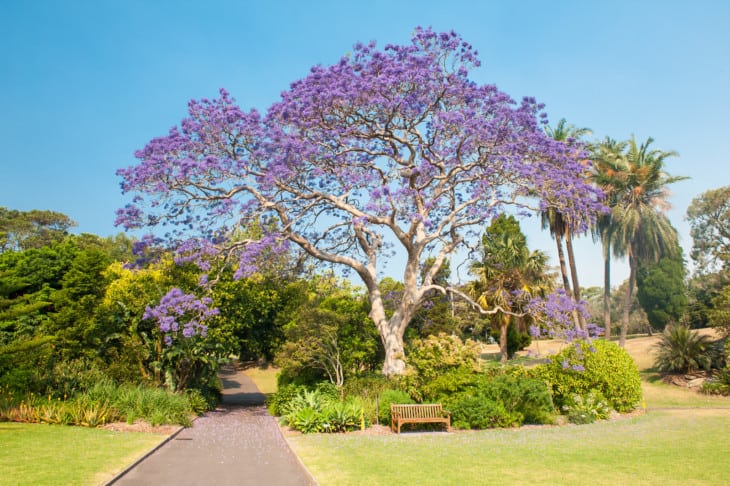
Jacaranda mimosifolia, the Jacaranda tree, are South American trees ideally suited to subtropical environments. They are, however, capable of growing in cooler areas, albeit at a slower rate. In these cooler regions, they also become deciduous instead of semi-evergreen.
The most significant similarity between the Japanese flowering cherry (Prunus serrulata) and the jacaranda is that, during spring, they put on an awe-inspiring display of flowers. The jacaranda generally produces purple/blue-purple flowers and comes in white varieties.
These trees vary in heights from roughly 10 feet to 60 feet, although most are between 10 and 25. Like Japanese flowering cherries, Jacarandas are highly ornamental, often lining the streets of suburbs for their springtime displays.

